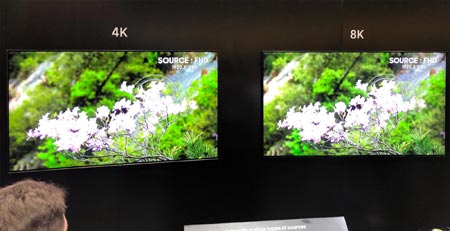At IFA 2018, we spent almost two hours learning about and examining Samsung’s first 8K TV, the Q900R, during a closed-room demonstration plus some additional time on the open show floors. Here are our first impressions along with technical information.
8K TV and upscaling
FlatpanelsHD had two people on spot for Samsung’s TV Innovation Room demo at IFA 2018. The Innovation Room is a recurring theme for Samsung during the big consumer electronics shows but this year’s version was different. Samsung used the opportunity to launch its first 8K TVs. So we decided to dedicate four eyes instead of only two.
The closed-room demo revolved mainly around Samsung’s 85-inch version of Q900R but the 8K TVs will be available in 75 and 65-inch versions, too – at least in Europe. Before we dig in, we should emphasize that Samsung has a no photo policy during these closed-room demos so the photos here are all from the open show floors.
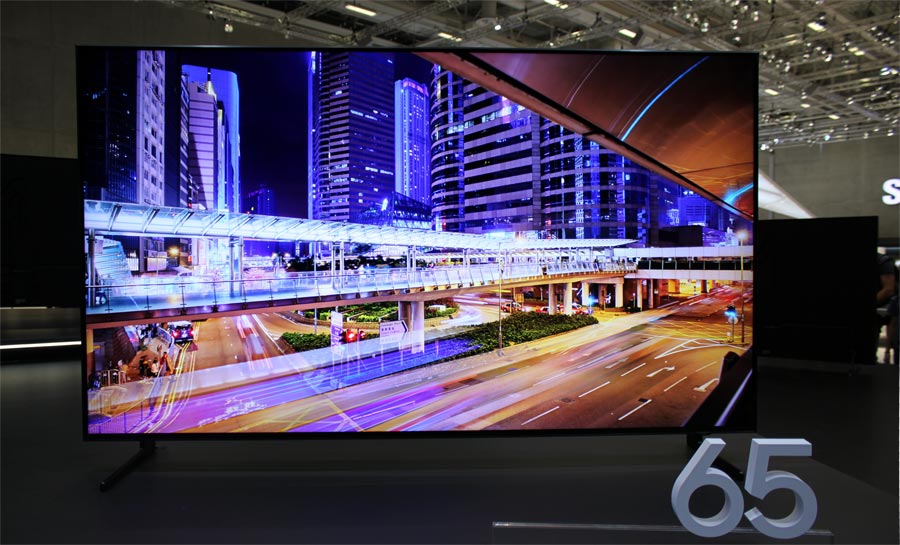
Samsung started out by giving us an eagle’s view perspective of the landscape and evolution of TV resolution, leading up to 8K. This is a subject for another time but if we had to highlight just a few of the points, it would be that processing power is now catching up and that Samsung honestly acknowledged that 8K content is nowhere to be found – except for some YouTube 8K video, which we will get back to in a moment.
After having acknowledged that there is no native 8K readily available, Samsung started talking specifically about Q900R’s “AI” (Artificial Intelligence) upscaling engine, which will be the big selling point. The company explained that it is using a combination of methods, including an object-based algorithm to detect objects in the picture - a flower, a human hand etc. The video engine then applies edge enhancement and detail enhancement to the upscaled picture and further tries to reduce grain / noise. The AI part comes into the equation in the form of a ‘formula bank’ – or database – that is based on algorithms trained via machine learning. The database can be updated over time.
To prove its point, Samsung initially compared side-by-side a competitor’s 8K display (Sharp, we believe) to the new Q900R. Both were fed the same 4K video signal, upscaled to 8K.
There was a visible difference in color and detail but colors also appeared oversaturated on Samsung’s TV. The picture on the Samsung Q900R had too high color temperature and contrast was clearly boosted, which made the picture look artificial at times. It certainly looked better but in large part due to the Sharp display being unusually contrast-poor with faded colors (we did not have a chance to confirm its picture mode / settings). Deep contrast can play a major role in how we perceive detail in a picture, for example in rocks and grass.
It was not a very good demonstration for evaluating resolution upscaling. The main point that Samsung proved here was simply that ‘better pixels’ – meaning higher contrast, wide color gamut, better luminance control – are more important than ‘more pixels’ at this point in the development cycle. This is why we continue to emphasize that one of the most important components of great picture quality today is pixel-level luminance and color control.
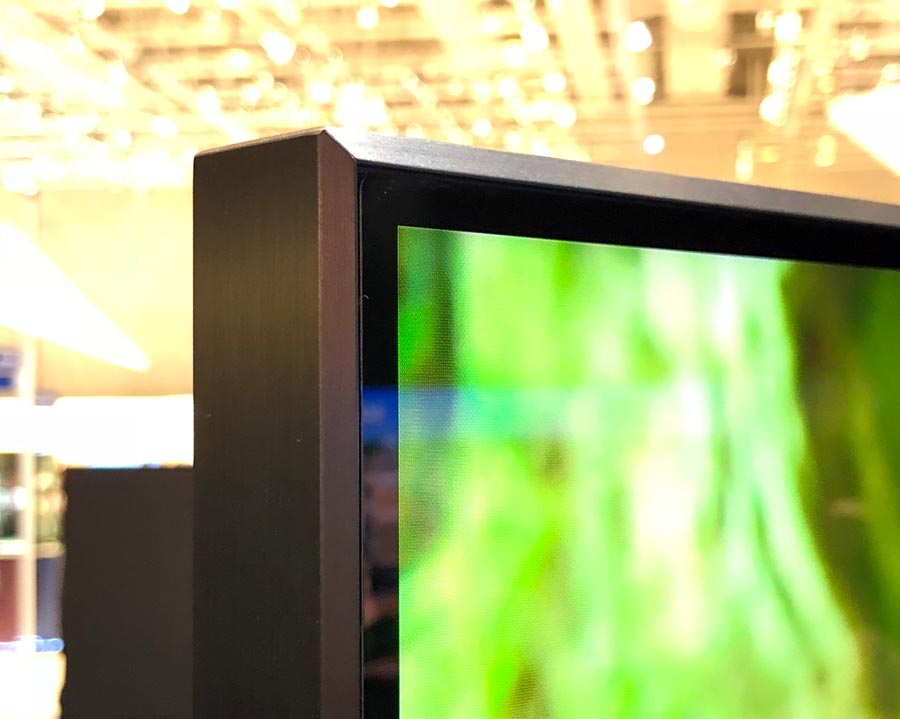
Now, there has been a lot of discussion pertaining to video upscaling over the years, and when walking around the show floors at IFA, several companies showcased 8K TVs, with all of them promoting “8K upscaling”, which… makes little sense. Without upscaling, a 4K video signal would take up only 1/4 of an 8K screen and a Full HD video signal only 1/16 of an 8K screen. Upscaling is a simple requirement, if you want a full-screen picture.
It is easy to impress an audience through means such as oversaturated colors and boosted contrast – manufacturers are doing it every day on the showroom floors to wow customers and sell TV – but the trained eye should be able to spot the differences between upscaling and picture enhancement. To us, most of the ping, pang, and pow came from picture enhancement, or rather by editing the pictures in various ways. This is not actually resolution upscaling, which is the process of recalculating pixels. Of course, more pixels will allow a manufacturer to do more in terms of picture enhancement and edge sharpening but it has very little to do with reproducing source-accurate video as the director envisioned.
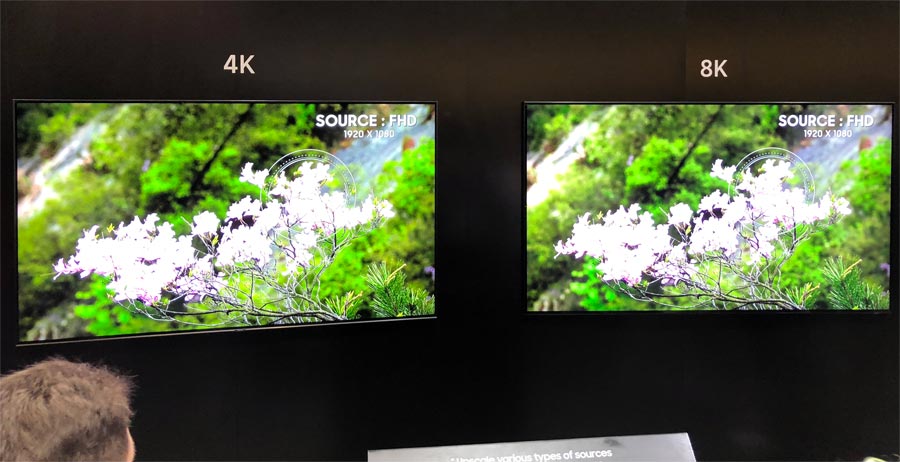
Samsung had a better demonstration outside on the open show floors where two TVs were placed side-by-side (as seen in the photos above and below). The left 4K display was showing either a SD, HD or 4K feed, and the right display (Q900R) was showing the same pictures upscaled to 8K. This demonstration allowed spectators to better evaluate the actual upscaling engine rather than other aspects of the picture. And while the right 8K TV reproduced pictures that looked consistently sharper and more detailed, we were not able to confirm technical details about the setup. For all we know, the two TVs could have been getting two separate video feeds.
That was the upscaling side of things and if we have learned anything from the past it is that manufacturers tend to hugely exaggerate their upscaling capabilities. In fact, early upscaling algorithms often tend to make pictures look worse. There is also a simple technical reason for why 8K is exactly 7680x4320 pixels. It is because 3840 * 2 = 7680, and 2160 * 2 = 4320. The first two respective numbers are what make up 4K resolution (3840x2160).
One aspect that Samsung did not address at all during these demonstrations is whether the eye can perceive differences between 4K and 8K from a normal viewing distance. However, the company briefly touched on the subject during its opening statements, and one point that Samsung made was that the old methods for quantifying the eye’s capabilities are not telling the full story. As mentioned, Samsung nevertheless used mainly the 85-inch model for its presentations where spectators were placed around 2-3 meters away. To enjoy the benefits of 8K resolution (versus 4K), in a living room, you will need a very large screen.
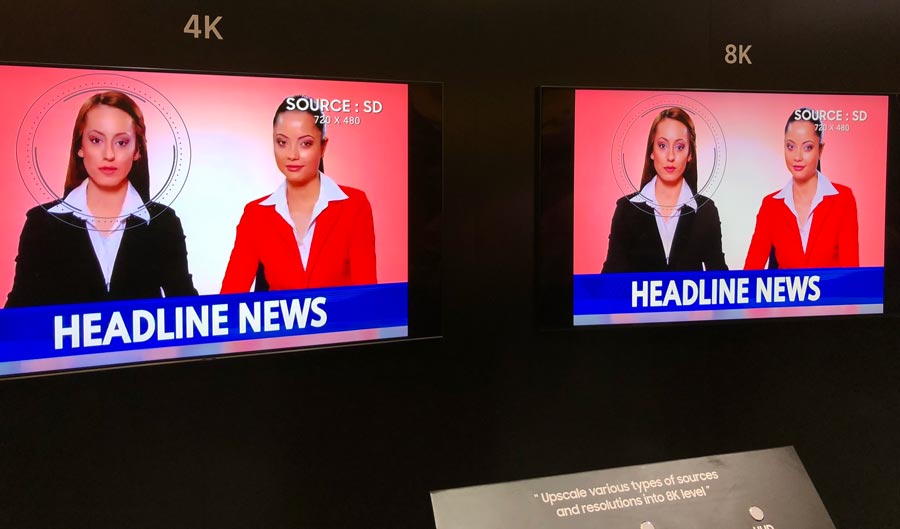
There were other demonstrations, too, including one scene with fireworks that pushed the TV to reproduce black and bright objects at the same time, which Q900R did convincingly, despite its limited number of dimming zones. We should emphasize that Samsung Q900R does not feature MFA (Micro Full Array) technology that Samsung demonstrated at CES 2018 in its Q9S prototype. One insider told us that the costs are simply too high right now, even for an 85-inch TV. Instead, Q900R uses a full array local dimming LCD panel that was described as being very similar to the system employed in the current Q9FN flagship 4K LCD TV. We did not spot any blooming or luminance issues during the demos.
All in all, it was very hard to assess the true benefits of 8K based on what we saw. Samsung Q900R can reproduce some wonderful pictures but we reserve final judgement for when have had a chance to properly evaluate and review Samsung Q900R.
Technical information
This is the first generation of 8K TV, and the term “first generation” always comes with caveats. We therefore tried to confirm as much technical information as possible during the session with Samsung’s Korean engineers.
First of all, Samsung said that Q900R is not certified for HDMI 2.1 at this time, mainly because the compliance test was finalized just last month. The company explained that it is seeking certification based on the HDMI1 port. The other HDMI ports will be limited to 4K video input. Still, there is a significant drawback because Samsung’s hardware is limited to 8K30 (8K at 30 frames per second). This is not a limitation of the HDMI 2.1 standard that can go far beyond but manufactures also have to make sure that their hardware can process all of this video information.
The same applies to the built-in HEVC decoder that will do 8K at up to 30fps. YouTube’s 8K streaming – which is more or less the only available 8K content today – is not supported.
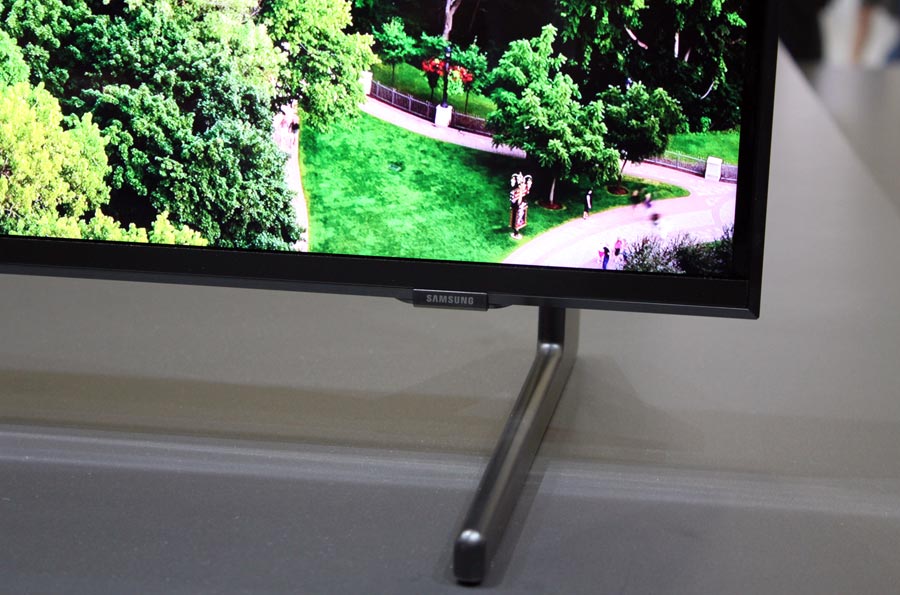
Ironically, from a picture quality standpoint, 30fps is far too low frame rate to maintain 8K resolution in moving images. Motion resolution will simply be a lot lower than 8K – lower than 4K, too. Some industry members have assessed that for 4K video we need to go beyond 50/60fps to retain resolution during motion so 8K will require even higher frame rate – unless you only want to look at still images.
This limitation should not be overlooked. When 8K content arrives someday, 30fps will rule out gaming and modern streaming players such as Apple TV and Nvidia Shield that render user interfaces at a higher frame rate. Just ask buyers of 2016 LG OLED TVs how they feel about Dolby Vision being limited to 30fps. It will take years for the content industry to adapt to 8K – they are just getting started with 4K. Perhaps the industry will continue to insist that movies be shot at 24fps but the simple fact is that higher resolution goes hand in hand with high frame rate (HFR), if you want the full benefits.
Samsung is circling back to its arguments about AI upscaling here. However, the fact is that early adopters of 8K TVs will find themselves in the exact same situation that first adopters of HD and 4K TVs found themselves in. And everything we discuss above are simply the limitations that we know about. Technology is changing all the time. You will be buying an 8K TV that is not actually fully ready for 8K content.
The good news is that Q900R will support many of the same HDMI 2.1 features as the current Q9FN 4K flagship, meaning FreeSync and VRR (Variable Refresh Rate) as well as ALLM (Automatic Low Latency Mode), which just means that the TV will automatically switch to its game mode when your start a game on your Xbox (PlayStation does not support ALLM at this point in time). Q900R will also support HDMI 2.1’s ‘Dynamic HDR’.
Q900R will not support eARC (enhanced Audio Return Channel) for outputting and passing through high-quality audio via the HDMI port. We also asked about QMS (Quick Media Switching), which eliminates the black screen when switching between frame rates via HDMI input but the Samsung engineers on spot were not sure, which probably means that it is not supported.
The thing with HDMI 2.1 is that it includes lots of exciting new features but – as you can see – manufacturers can decide not to include all of them. The HDMI organization allows manufacturers to cherry pick.
As for the design, Samsung has gone with a rather traditional design. There are no bells and whistles and the TV is also relatively thick in order to accommodate the zone dimming backlight. It looks as if the two feet can be moved inwards for a narrower configuration but the Samsung representative was not sure. The logo has been moved to the right side of the frame.
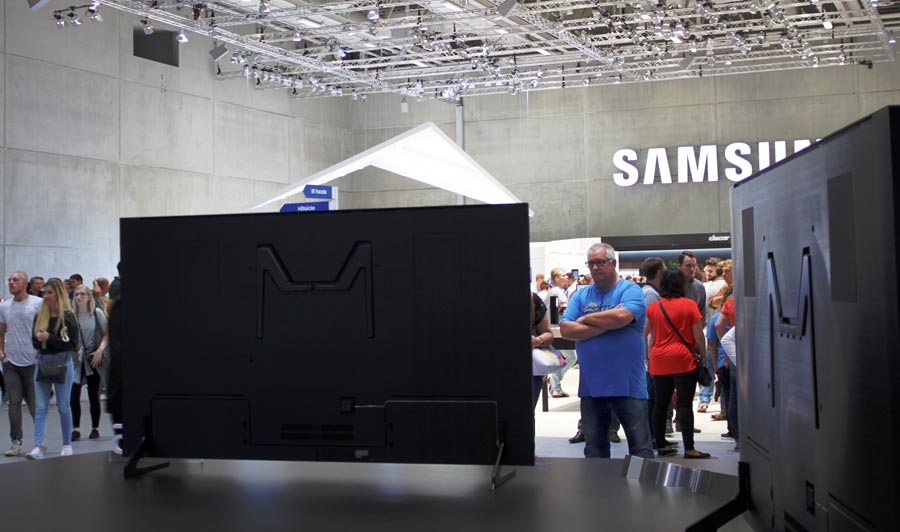
Colorfront HDR demonstration
Samsung did not put a lot of emphasis on HDR during its demonstration, which is only natural considering that they are trying to push the 8K narrative here. However, they had invited a representative from Colorfront who creates professional software for video post-production.
The Colorfront representative was clearly excited about the potential of modern HDR TVs, with wide color gamut and high peak brightness. He even went as far as to say that he is “very disappointed in cinema visual quality” and that living room TVs are now pushing the video industry forward, especially in the area of HDR.
It should be noted here that there are some differences between the Q900R sizes. The 85-inch model will do 4000 nits peak brightness, according to Samsung, but the smaller versions are limited to 3000 nits.
The Colorfront representative gave us a short HDR demonstration to highlight Samsung Q900R’s capabilities in terms of high brightness and color compared to a Samsung 4K TV as well as the 30-inch Sony BVM-X300 reference OLED monitor used in Hollywood studios. The reference monitor was clearly outperforming both TVs but it is also extremely expensive.
Q900R delivered impressive HDR but at times it suffered from the same limitation as other zone dimming LCD TVs. There are simply not enough dimming zones so oftentimes actual peak brightness is far lower than 3000-4000 nits that the TV in theory is capable of. In fact, the Sony BMV-X300 reference monitor would at times reproduce specular highlight with more luminance intensity, despite it having “only” 1000 nits peak brightness, which can be explained by its pixel-level luminance control. We have observed this many times during reviews when comparing OLED TVs to LCD TVs. Of course, in less challenging movie scenes, the best LCDs can hit significantly higher brightness levels than OLED TVs but sometimes it comes at the expense of black levels.
A side note: There is a way to quantify color performance at different luminance levels (for HDR) called ‘color volume’ – which Samsung likes to highlight – but as a rule of thumb it does not take into account absolute black level, and neither does it account for changes in dynamic range and black levels as a results of the TV’s zone control or ABL. This theoretical measurement needs to be improved before it can tell us about real-life performance of a TV.

He also made some very good points about the state of display technology today, saying that LCD and OLED both have strengths and weaknesses. For example, consumer-grade OLED TVs use an extra white subpixel, which can affect color saturation at peak brightness levels. Of course, this is not new information but it is relevant when comparing TVs to the Sony OLED reference monitor that uses RGB OLED, which can maintain color saturation at all brightness levels. You may recall that Samsung, some years back, tried to commercialize RGB OLED TVs but they ultimately had to back away due to high costs and low yields.
No display is perfect and there is a lot of upside in the current HDR standards but it was an interesting perspective from a company who works with Hollywood studios to grade and optimize content. Of course, Colorfront is now fully compliant with HDR10+ that Samsung is pushing as an alternative to Dolby Vision.
To sum up, this is first generation 8K TV and it comes with limitations that should not be ignored. It was very difficult to evaluate Samsung’s “AI” upscaling based on what we saw so we look forward to getting our hands on a review sample. 8K will happen and 8K content will materialize but it will take time. Of course, we have to start somewhere and we applaud Samsung for pushing the envelope but is the hardware even ready? We are not entirely convinced that it is.
The 85-inch Samsung Q900R will be available in the US in late September for 14000 USD. In Europe, Samsung will launch 65, 75, and 85-inches models in October for 5000, 7000, and 15000 Euro, respectively.

